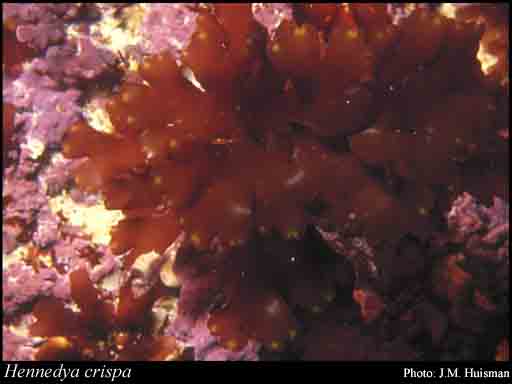- Reference
- Trans.Roy.Irish Acad. 22:552 (1855)
- Conservation Code
- Not threatened
- Naturalised Status
- Native to Western Australia
- Name Status
- Current

Scientific Description
Habit and structure. Thallus medium to dark red-brown, cartilaginous, 5–20 cm high, subdichotomous to alternately and more-or-less complanately branched, upper branches undulate, (2–)4–10 mm broad (narrower above) and 150–400 µm thick, with broad, notched, apices, lower parts in older plants becoming stalk-like by thickening of the central blade and loss of margins, often proliferous from the stalks. Holdfast discoid-conical, 2–15 mm across; epilithic or on shells. Structure multiaxial, developing a relatively narrow filamentous medulla and a pseudoparenchymatous cortex, with the inner cells on both sides forming a distinctive layer of large, isodiametric cells 60–100 µm across, with some small cells between them and the small-celled outer cortex 3–5 cells thick, outermost cells 2–4 µm in diameter. Rhodoplasts laminate, 1–3 per cell.
Reproduction. Sexual thalli monoecious; procarpic. Carpogonial branches 2-celled, borne singly on a supporting cell just inside the large inner cortical cells, inwardly directed with reflexed trichogynes. Supporting cell acting as auxiliary cell, with numerous nutritive filaments produced from adjacent vegetative cells; gonimoblast initials several, rounded, developing filaments which line a cavity formed by breakdown of the auxiliary and adjacent cells, and forming centripetal interlinked filaments with terminal obovoid carposporangia 12–18 µm in diameter. Cystocarps (1–3) submarginal near branch apices, protruding and sometimes basally constricted, 0.7–1 mm across, with filamentous enveloping tissue and a cortical ostiole. Spermatangial clusters urceolate, 12–20 µm across, sunken in the outer cortex, with 4–5 initials each forming a single ovoid spermatangium 1–2 µm in diameter. Tetrasporangia scattered in young branches, lying within the outer cortex and pit-connected to mid cortical cells, ovoid, 30–40 µm long and 15–25 µm in diameter, zonately divided.
Distribution. Geraldton and the Houtman Abrolhos, W. Aust., to Pearson I., S. Aust.
Habitat. H. crispa is a deep-water alga.
[After Womersley, Mar. Benthic Fl. Southern Australia IIIA: 368–369 (1994)]
Distribution
- IBRA Regions
- Esperance Plains, Geraldton Sandplains, Jarrah Forest, Swan Coastal Plain, Warren.
- IBRA Subregions
- Geraldton Hills, Perth, Recherche, Southern Jarrah Forest, Warren.
- IMCRA Regions
- Abrolhos Islands, Central West Coast, Kimberley, Leeuwin-Naturaliste, WA South Coast.
- Local Government Areas (LGAs)
- Albany, Augusta Margaret River, Broome, Busselton, Cockburn, Dandaragan, Esperance, Fremantle, Greater Geraldton, Irwin, Mandurah, Northampton, Rockingham, Wanneroo.